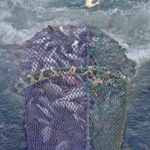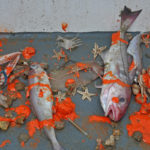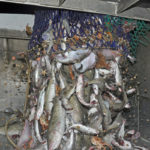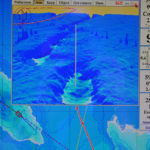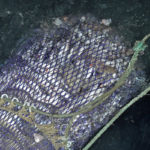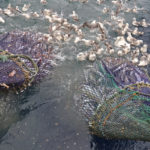David Linkie looks back to a whitefish trip on Fraserburgh skipper Sandy West’s twin-rig trawler Virtuous FR 253 in August 2012
Skipper Sandy West had taken aboard a good mix of cod, haddock and whiting, together with a couple of baskets of monkfish, from his closing haul 18 hours earlier. It was therefore not surprising that he set a course back towards the remains of the Pumper platform, some 80 miles east of Orkney, when Virtuous cleared the Peterhead breakwaters after making a brief half-landing of 240 boxes, including 170 of cod, caught in just 30 hours of fishing.

01. The 23.3m Virtuous was completed by Parkol Marine Engineering at Whitby in August 2010.

02. The Crescent Hole delivers.

03. Alexander and Sandy West mending a net.

04. Virtuous fishroom man Jolito boxing cod.

05. Shooting away the twin-rig trawls.

06. The 1,000kg middle roller, manufactured by Premier Engineering of Scarborough.

07. Hauling for the first time.

38. A rarity caught on the other side of the camera lens, following the launch of John Addison’s book BCK Motor Boats Volume 2 at the Buckie and District Fishing Heritage Centre.

08. Taking the port codend aboard.

09. Clear evidence of healthy North Sea cod stocks.

10. Starting to empty the catch hopper.

11. Baskets of cod ready for boxing.

12. Another fishroom delivery on its way.
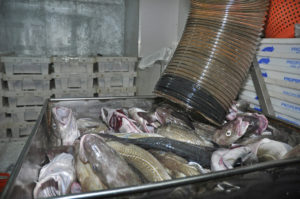
13. A well-filled fishroom selection trough.

14. Skipper Sandy West completes his first e-log of the trip.

15. Shooting away the port net groundgear and flip-up ropes.

16. Quick preventative action in removing a thoughtlessly discarded five-gallon drum of paint from the hopper averted a potential disaster.

17. Jolito and Sandy and Alexander West lacing a 127mm codend onto a reserve net.
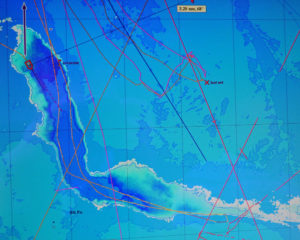
18. Virtuous towing in the north end of the aptly named Crescent Hole.

19. Taking another haul aboard.
Since the northward ebb tide proved beneficial shortly after leaving Rattray Head off the port quarter, the crew were called less than 10 hours later, by which time Virtuous had steamed almost 100 miles in near perfect conditions.
Fifteen minutes later, Virtuous was towing into the northwest and a strong tide at 2.9 knots, with the Mitsubishi main engine running at an economical 1,120rpm and the Scanmar ScanMate 2 net-monitoring system showing a door opening of 72.5 fathoms in a similar depth of water. With 205 fathoms of wire shot, Virtuous was using a set of Thyborøn Type 11 trawl doors (66in/540kg), a 1,000kg roller clump and 60 fathoms of sweeps (40 fathoms of 28mm-diameter combination and 20 fathoms of rubber legs on 18mm wire) to spread 180ft twin-rig prawn scraper nets rigged on 6in and 8in discs.
Evolved from the previous generation of twin-rig prawn scrapers, the comparatively higher-standing nets that Virtuous was towing were the same as skippers Sandy West and Keith Buchan had used on previous prawn trips. The only differences were that – to ensure full compliance with TR1 regulations – codends measuring 127mm (7mm bigger than the specified requirement) had been fitted in place of the 80mm TR2 bags, and that the escape vents fitted above the inclined panels, required to be used by TR2 vessels, had been blanked off, at the same time as the panels themselves had been cut on a bar to allow cod through. The 200mm square mesh panel that was required to be positioned ahead of the inclined panel was left in, while a 126mm SMP, rather than the statutory 110mm mesh escape panel, was positioned as usual 15m ahead of the codend.
Brought to an end as darkness descended, the first haul resulted in 12 boxes, mainly cod, which were subsequently entered into the first column of the running fishroom tally sheet in the wheelhouse. Slightly disappointed by the quantity of fish lying in the hopper, Sandy West reduced the length of wire shot for the next tow to 175 fathoms in an attempt to increase headline height at the expense of spread, which was reduced by two fathoms. Five hours later, a 50% increase in the amount of fish transferred to the fishroom justified this decision.
Cod were placed head to tail four to a box, sprags in sixes, and medium codling at 16 to 18 to give a target box weight of 35kg. Boxing the catch in the minimum timescale to ensure optimum quality was enhanced by the Geneglace ice machine delivering a constant supply of freshly made flake ice that was easy for the holdmen to quickly scoop into baskets and lightly scatter over the fish.
Although the first two tows had been taken on shoal banks, Sandy West was keen to take the dawn tow in the Crescent Hole, for which he was now well placed. Shaped as the name suggests along a north-west axis, the Crescent Hole is six miles long and half a mile wide. With some fairly steeply sloping sides, it reaches depths of 110 fathoms in places, compared to 70 fathoms along the outer edges.
Closely watching the Olex 3D seabed display, skipper Sandy West eased the gear down the eastern side of the hole, gradually increasing the depth of water to 90 fathoms. Although the Furuno DDF1 Navnet dual-frequency (50-200kHz) sounder had shown some isolated marks of fish tight to the bottom during the first two tows on the banks, noticeably more life was now being displayed, including the occasional blood-red echo indicating a greater density of fish. This was confirmed when the nets were hauled towards the transom shortly before 8am at the end of a four-hour tow, during which Virtuous had turned through 180° before heading back towards the start of the tow and an intersection of pipelines clearly displayed on the FishSafe unit, including a new pipe installation that another Fraserburgh trawler, Harvest Moon, was guarding a mile away into the southeast.
Apart from the seiner Acorn INS 237, steaming southeast towards the Claymore Bank on the Thursday afternoon shortly before Virtuous starting fishing, and, eight hours earlier, Moremma PD 135, returning to Peterhead after an oil job, skipper James Third’s Harvest Moon was the only Scottish fishing boat seen in over three days at sea, until Virtuous headed back to Peterhead 72 hours later a few miles ahead of Karen Ann II FR 559, which was also returning home after 21 days of guardship duties. Apart from being a disappointment for someone with a camera usually close at hand, this distinct lack of fishing activity – in areas where 15 years earlier up to 20 boats could easily have been expected to be seen – provided a stark reminder of the extent to which the Scottish fleet had been downsized in recent years.
Visibly buoyed by a catch hopper half full of prime whitefish, including good-sized whiting, megrims and monks, skipper Sandy West and the crew quickly reshot the twin-rig trawls before taking another tow more down the centreline of the Crescent Hole into the flood tide. Two hours later, holdman Jolito reported that the fishroom tally had been boosted by 38 boxes, which the crew celebrated with a tasty omelette quickly produced by Alexander West.
Shortly after skipper Sandy West had completed his daily e-log and sent it to Marine Scotland via satellite, the fourth haul nudged the running total towards 90 boxes – although it could so easily have resulted in 22 boxes having to be discarded because of a five-gallon drum of bright orange paint thoughtlessly thrown over the side, probably from a standby vessel. Fortunately – with the contents of the codend already lying in the hopper and therefore at risk – the paint container must have entered the port net near the end of the tow, so that when it fell unseen into the hopper, Jolito was able to quickly climb in and immediately lift it onto the shelterdeck before any fish were contaminated.
Bringing a further 20 boxes of similar-quality fish, the fifth haul also brought a setback when the starboard net surfaced with the torn-out port shoulder hanging into the belly – probably the result of something heavy being picked up by the flip-up ropes, before being tipped out shortly before hauling. Although such problems are of course a common occurrence, this incident was of considerably more significance because the second set of similar prawn scraper trawls carried on the split net drums were without codends, as they had been left ashore to comply with TR1 regulations.
Although skipper Sandy West was keen for the trawls to be shot for the darkening tow, the start of this was delayed for nearly an hour while the codend was cut off the torn net and laced onto an otherwise ready spare net.
Taking the opportunity to steam a few miles into the southwest while the codend was swapped over, he opted to take the next tow in Tommy Rae’s Hole. This decision was justified by the second-best count so far – 24 boxes – being stored and iced by 1am on Saturday morning.
The integrated storage/washing system fitted on Virtuous, which included seven selection compartments (five square inline flanked by two elongated rectangular ones to reduce the unit’s overall length), each of which were served by an integral water supply, enabled the four crewmen to deliver each haul to the fishroom in the minimum timescale and to maintain catch quality.
Again opting to keep in shallower water during darkness, Virtuous took the next haul into the northwest on the plateau between the holes, where a third of a lift a side produced 20 boxes of superb-quality fish. That only large whiting were sliding through the hopper hatch onto the gutting table highlighted the number of mature whiting that were being lost by using the 200mm and 126mm square mesh panels.
The smaller four-mile-long Johnny Morrice’s Hole was skipper Sandy West’s choice for the lightening tow on Saturday morning, which he entered by towing southeast into the hole from the north side of the Brent pipe. Towing into the tide, which provided more favourable conditions in the event of coming fast, when the tidal flow can sometimes help to take a net out, Virtuous started towing into deeper water. After starting at 70 fathoms along the west side of the hole, increasing signs of life tight to the bottom, as well as higher-standing feeding, were seen while towing into the southwest corner, where the water depth was 97 fathoms.
With the starboard door continually climbing up the bank, the port one was positioned considerably lower, as indicated by the reduced door to clump spread indicated on the Scanmar display. When the 100-fathom contour was reached, the engine speed was eased back by 50rpm to 1,010rpm to ensure that the tickler chain would continue to dig into the bottom. With marks having become less frequent beyond 95 fathoms, Sandy West eased Virtuous back towards this depth, while constantly observing the 2D and 3D display on the Olex system.
Being given the opportunity to watch and listen to Sandy West’s thinking for nearly five hours since entering Johnny Morrice’s Hole, including the forward planning and the decisions he was continually making, provided a unique insight into the benefits that seabed mapping systems offer, as well as the skill needed by a skipper to realise the potential advantages that 3D displays bring. Having identified the best route out, Virtuous towed across a relatively gentle incline up onto the bank, before the Doosan AD126TI auxiliary engine (209kW @ 1,500rpm) was switched on once more to drive the main hydraulics.
Releasing the codends brought refreshing smiles all round, as did the later news that the eighth haul had contributed 31 boxes to a tally that was nearing 200 boxes after 36 hours’ fishing.
Not wanting to overplay his hand in the holes, Sandy West kept to the plateaux for the next two hauls, while starting to think about shortening the distance to Peterhead from the end of the last haul.
Following a routine ninth haul for 18 boxes – which also produced another unwanted example of discarded commercial waste in the form of a 10m length of cut-off handrail, which fortunately was extracted from the belly of the port net by using an angle grinder before too much damage occurred – the penultimate tow was taken in 70 fathoms between the Johnny Morrice’s and I&F holes. This provided an understandable stir of enthusiasm on the quarter and in the wheelhouse when the starboard net surfaced to reveal a considerable number of big ling – which previously had been conspicuous by their absence – still making their way down the bag into the codend as the net was dried up. Quickly clipping the Gilson wire onto the dog rope resulted in an initial estimate of 15 boxes of ling being released into the hopper, along with what had almost become the expected mix of sprags, whiting and monks.
Holding more than sufficient quota for the unexpected haul of ling added to Sandy West’s satisfaction when he looked at the hopper while taking the second net aboard, which produced a similar mix of whitefish, but without the ling. This marked imbalance was attributed to good fortune, in that the better-fished net had passed rather too close to a wreck or a patch of hard bottom for comfort, although nothing was shown on the plotters. It is often said that fortune favours the brave, and – alongside the decision to switch over to whitefish for a week – skipper Sandy West’s decision had proved the correct one for several reasons.
A fine supper of mince and tatties, followed by toffee ice-cream, helped to replace some of the energy the crew had used in putting another 32 boxes down into the fishroom. These were followed by a further 25 boxes when the gear was hauled for the last time one hour after nightfall, when Virtuous had 96 miles to steam for Peterhead.
After five hours in their bunks, the crew were called to begin the work of power-washing Virtuous from stem to stern and cutting off the TR1 codends in preparation for leaving Peterhead the back o’ Sunday to resume prawn fishing again.
Shortly before 10am on Sunday morning, Virtuous drew alongside Peterhead fishmarket, when a tally for 287 boxes, including 153 of cod, 20 of flats, 24 of monks, 36 of haddock, 22 of whiting and 18 of ling, caught within the previous 78 hours, was passed ashore to the market man.
Catch-wise, the second whitefish half-landing, like the first, had been justified, although the ultimate measure of success, the bottom-line settling, which was totally dependent on market prices, would not be known for another 24 hours, when the catch would be sold by Peter & J Johnstone Ltd for the Fraserburgh-based Westward Fishing Company.
Although Virtuous landed to what turned out to be a big market of 5,300 boxes, with haddock comprising half of this total, cod was in fairly short supply. This worked to skipper Sandy West’s advantage, with green securing £2.30-£3.20, ling £2.20-£2.70 and monkfish up to £4 per kg. These prices were sufficient to justify the significant costs incurred in leasing cod – although as always, a fine line existed with regard to financial viability.
Whitby-built Virtuous
With overall and registered lengths of 23.3m and 22.7m, beam of 7.2m and a draught of 4.8m, Virtuous was designed by Ian Paton of SC McAllister & Co Ltd and built by Parkol Marine Engineering at Whitby in 2010.
On starting to fish from Fraserburgh at the beginning of September 2010, Virtuous immediately established a reputation for being one of the fastest and most fuel-efficient vessels of her class in the Scottish fleet, returning a daily fuel consumption of less than 1,500 litres. Although the trawler’s new nets became heavier after the first few trips due to the inevitable build-up of mud, by usually towing the twin-rig gear at 1,000-1,100rpm, Virtuous subsequently maintained this highly economical performance level by typically using under 9,000 litres for six-day trips and just over 10,000 litres for seven-day trips.
Developing 470kW @ 1,350rpm, the Mitsubishi S6R2 MPTK main engine is coupled to a Reintjes WAF 374 7.043:1 reduction gearbox. This combination results in the 2,300mm-diameter propeller turning at a maximum speed of 192rpm, and one of around 150rpm when typically towing at 1,050rpm.
When a new Virtuous was nearing completion at Whitby in August 2019, her predecessor was renamed Accord BCK 262 after being bought by Buckie skipper Michael Alexander Wilson.
Vessel versatility and viability vital
2012 is remembered as the year that featured one of the leanest and longest spring/early summer seasonal shortages of prawns in the North Sea for over 15 years.
Some of the best prawn fishing ever seen occurred in January and February 2011, when boats were getting 100st-plus days in Bressay waters, 15 miles northeast of where Virtuous fished this trip. However, within days of the Tōhoku tsunami in March 2011, prawn catches in the northern North Sea plummeted. The continuing marked scarcity created growing concerns across the catching and processing sectors, until welcome signs of improvement showed in late August 2011.
The need to meet bank commitments and keep skilled crews against a backdrop of near-record fuel costs were just some of the problems skippers faced. At the same time, prawn processors ashore were desperate for supplies to ensure that hard-won sales outlets in Europe and further afield could be retained, rather than being lost to competitors in what is a fiercely contested international marketplace.
While guard work offered an alternative revenue stream for some vessels, this did nothing to help processors, who were relieved when a number of Fraserburgh/Peterhead skippers took the option of fishing on the west coast for two to three months, during which time they frequently worked in areas seldom, if ever, fished by local west coast trawlers, including the Stanton Bank and Barra Head waters.
When prawn catches dipped following the customary seasonal appearance of blackwater in the Minch and the highest tides of the year, Virtuous was one of several Fraserburgh trawlers to lease west coast TR1, days before catching mainly haddock south of Barra Head for two trips, before reverting to prawns again.
Virtuous was refitting at Fraserburgh when east coast trawlers were stopped from fishing prawns west. When skippers Sandy West and Keith Buchan returned to sea, they decided to try grounds east of Fraserburgh that usually provide a steady return of prawns from mid-summer onwards. At a time when seasonal patterns appeared to be constantly changing for unknown reasons, a totally unviable catch rate of just a few baskets of prawns led the partners to join several of their counterparts in fishing prawns off southeast Scotland, from where they landed one and a half trips into Aberdeen.
Hearing all too familiar poor reports from boats looking for prawns out east, while steaming Virtuous north to Fraserburgh from Aberdeen, skipper Sandy West started to evaluate the limited options open to him. In a nutshell, these consisted of possibly enduring an unviable six-day prawn trip – which would not help the mood of skipper and crew already disheartened by the fact that they were unable to access grounds yielding reasonable quantities of prawns – or limiting the potential losses by tying Virtuous up until prawns started to show again on the offshore North Sea grounds.
After delaying sailing on the Sunday night to hear the first (poor) reports from boats the following morning, plan C – which had started to take shape 48 hours earlier, when sufficient North Sea TR1 days for a trip were sourced for possible leasing, together with the all-important cod quota – was swiftly implemented.
While the crew removed the 80mm codends from both sets of twin-rig prawn discer trawls wound on Virtuous’ net drums, and replaced two of them with bags (valued at £1,000 each ready to fish) made from 127mm mesh, before cutting the inclined panels on the bar to allow the cod through and blanking off the associated opened vents, Sandy West spent most of the day in various offices around Fraserburgh harbour, checking that all the necessary paperwork was in place and verified by Marine Scotland, before sailing at 8pm.
Nature in play in evolving stock cycles
The degree to which fishing continues to be influenced by the natural marine environment was clearly illustrated by the fact that Virtuous was catching good-quality mature whitefish on the same grounds that just one and a half years earlier had regularly yielded 20-40st hauls of clean prawns for Fraserburgh twin-rig trawlers.
Although some skippers thought that a succession of more severe winters, followed by frequent periods of colder northeasterly winds rather than warm westerlies, could have been partly responsible for prawns staying buried deep in the mud, they also pointed out that similar cycles had occurred before, particularly in 1996, since when there had been a steady year-round prawn fishery between all the places in the North Sea that Fraserburgh twin-rig skippers would expect to visit during the year.
For nearly 10 years, the consistent year-long prawn fishery had been experienced during a time when cod stocks went through a perceived dip. Now, when cod were abundant, concern was expressed that the large numbers of cod and other species of mature whitefish present on a wide swathe of infrequently fished ground were feeding on prawns whenever they left their burrows.
This possibility appeared to be reinforced by some cods’ stomachs revealing evidence of prawns on gutting, together with considerable numbers of mature herring, which several Scottish pelagic boats were fishing further west off Start Point, at the same time as some Danish and Dutch midwater vessels were fishing southeast of Virtuous. Whatever form of food cod were taking, given the large healthy fish seen on this trip, it was obvious that considerable amounts of food were being consumed daily on the seabed.
Mother Nature has a strong track record of self-healing – but there was a risk that, not being fully understood by scientists, the natural restorative properties in play could be adversely affected as a result of this balance being distorted by new fisheries regulations that could ultimately prove to be benefiting cod to the considerable detriment of other species.
Good things come to those who wait
This long-awaited trip on Virtuous came out of the blue at the end of a busy few days in which weather presented a number of unexpected challenges.
The first materialised less than an hour after leaving the house early on a Sunday morning, making for Peterhead. Fifteen miles after reaching the 1,500ft summit of Carter Bar on the England-Scotland border, the drive into Jedburgh, along what had rapidly become a severely flooded main road, brought the unprecedented sight of emergency crews in RIBs attempting to rescue residents who had woken up to find that flash flooding had left them stranded in upstairs rooms. Due to pure good fortune and a reliable diesel engine, I managed to be one of the last cars to drive the 10 miles along the A68 between Jedburgh and St Boswells, even though the floodwater was well over the axles on numerous occasions.
Later than expected, a relieved driver arrived at Stonehaven to meet and photograph Mike Park, who had completed his gruelling training programme ahead of his attempt to row single-handed across the North Sea.
After a night of torrential rain at Peterhead, the skies lightened shortly after 10am, with the result that 90 minutes later, the sun was shining brightly when Sir Albert McQuarrie unveiled a plaque following the renaming of the quay he had played a key role in making possible 20 years earlier. The deepwater driving skills honed the previous day proved beneficial during the two-mile drive from the Sir Albert Quay to a reception lunch at the Buchan Braes Hotel in Boddam, due to the main road through Stirling village being left badly flooded.
Photographing the new inshore static-gear fast boat Acadia was one task on the to-do list for the following day, which dawned warm and sunny. As if on cue, the sky became threatening literally while boarding the Peterhead pilot boat from the south breakwater, and by the time AJ and William Buchan helpfully steamed past 30 seconds later, the lifejacket was the driest part of my clothing – but at least the photographs were on the memory card.
Scheduled to be at Stonehaven in one hour’s time for Mike Park’s departure, there was no other choice but to drive soaked through. No wonder my appearance drew some curious glances on joining the crowd of well-wishers waiting to give Mike a rousing send-off in a sunny Stonehaven.
Wednesday resulted in the unusual occurrence of my being in front of a camera lens rather than behind it, after being invited to help launch John Addison’s latest book, BCK Motorboats Volume 2, at the Buckie and District Fishing Heritage Centre.
With the images from an extremely productive three days in the bag, the evening gave a more relaxed opportunity to get some much-needed photos of whitefish vessels landing at Peterhead. The plan was to head back down the road the next day to start writing up a combination of news stories and features.
However, making the most of feature opportunities whenever they might arise is crucially important. Having already been forwarded an email indicating that a really good one was probably about to present itself, there was no surprise when the mobile rang shortly after 1am.
“We will be in to land at Peterhead for 3am, and sailing again by 6am. If you’re down at the market by 5am, you are more than welcome to come away with us for three days,” Fraserburgh skipper Sandy West said, speaking via satellite phone. Having waited two years for such an opportunity since Virtuous was launched at Whitby, the answer was a no-brainer.
As a result, the next three hours were spent writing and emailing news stories for the following week’s issue of Fishing News, rather than chance any possible satellite broadband difficulties over the coming days.










